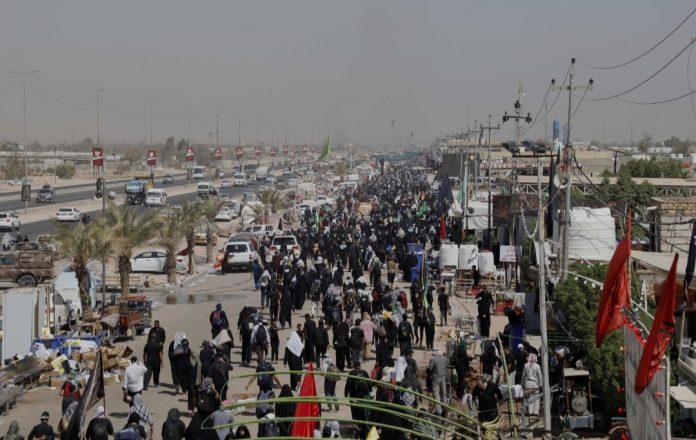By Ateeqa Zehra
The Arbaeen is one of the most significant religious gatherings in the world, marking the end of the 40-day mourning period after Ashura, the day on which Imam Hussein, the grandson of Prophet Muhammad, was martyred in the Battle of Karbala in 680 AD. This pilgrimage, which takes place annually in the city of Karbala, Iraq, draws millions of Shia Muslims from around the globe. It is a powerful symbol of faith, unity, and humanity.
The Significance of Arbaeen
Commemoration of Imam Hussein: Arbaeen is primarily a mourning period to commemorate the martyrdom of Imam Hussein. His stand against tyranny and injustice serves as a timeless inspiration for Muslims and non-Muslims alike. His unwavering commitment to principles of justice and righteousness resonates with people of all faiths.
Unity among Muslims: Arbaeen transcends sectarian boundaries. Shia and Sunni Muslims alike participate in this pilgrimage, reaffirming the spirit of unity and brotherhood that Islam emphasizes. It is a testament to the idea that despite theological differences, Muslims can come together in the name of love and respect for Imam Hussein.
A Message of Peace and Compassion: Arbaeen is not just a religious observance; it is a global message of peace and compassion. Pilgrims often serve as a living example of selflessness, providing food, water, and medical aid to fellow travelers. This display of kindness and humanity extends beyond religious affiliation and national boundaries.
The History of Arbaeen
The origins of Arbaeen date back to the earliest days of Islam, following the tragedy of Karbala. The term “Arbaeen” itself means “forty” in Arabic, signifying the 40 days that passed since Imam Hussein’s martyrdom. However, the pilgrimage as it is known today has evolved over the centuries.
Early Observance: Initially, Arbaeen was observed privately within the Shia Muslim community, with individuals and families paying their respects at the shrine of Imam Hussein. It wasn’t a large-scale public event.
Revival under Saddam Hussein: The Arbaeen pilgrimage saw a resurgence during the rule of Saddam Hussein. He attempted to manipulate this religious gathering for political purposes, but this led to a crackdown on Shia religious practices. As a result, the pilgrimage went underground, with many participants risking their lives to observe it.
Post-Saddam Era: Following Saddam Hussein’s fall in 2003, the Arbaeen pilgrimage experienced a revival, with millions of pilgrims from Iraq and around the world participating each year. The event has continued to grow in size and significance.
The Rituals of Arbaeen
The Arbaeen pilgrimage involves a range of rituals and practices that reflect the profound grief and reverence felt for Imam Hussein.
Walk to Karbala: The most iconic aspect of Arbaeen is the long journey on foot to Karbala. Pilgrims walk for days, sometimes even weeks, covering hundreds of kilometers to reach the holy city. This journey symbolizes the sacrifices made by Imam Hussein and his companions, who walked to Karbala despite knowing their fate.
Mourning and Prayers: Upon reaching Karbala, pilgrims gather at the shrine of Imam Hussein. They engage in collective mourning, recite prayers, and offer supplications for the well-being of their families and the world at large. The atmosphere is filled with a profound sense of spirituality and devotion.
Acts of Kindness: Pilgrims also engage in acts of charity and kindness during their journey. They set up makeshift stalls, providing free food, water, and medical services to fellow travelers, regardless of their religious or cultural background. This tradition exemplifies the universal message of compassion.
Reflection and Self-Purification: Arbaeen is a time for self-reflection and spiritual purification. Pilgrims use this period to seek forgiveness for their sins, strengthen their faith, and renew their commitment to the principles of justice and righteousness.
The Universal Messages of Arbaeen
Unity and Tolerance: Arbaeen demonstrates that unity and tolerance are achievable goals for humanity. It brings together people from diverse backgrounds, fostering a sense of global brotherhood and unity.
Resistance against Injustice: The stand of Imam Hussein against oppression and tyranny serves as a timeless example. Arbaeen reminds us all to resist injustice and promote justice, no matter the odds.
Humanitarianism: The selfless acts of kindness during the pilgrimage emphasize the importance of helping those in need, regardless of their faith, nationality, or social status. Arbaeen reminds us of our shared humanity.
Peace and Compassion: Arbaeen is a powerful call for peace and compassion in a world often marked by conflict and division. It urges us to put aside our differences and work towards a more harmonious world.
Conclusion
The Arbaeen Karbala visit is not merely a religious gathering; it is a testament to the enduring power of faith, unity, and humanity. It draws millions of pilgrims from diverse backgrounds to Karbala, Iraq, every year, sending a universal message of peace, compassion, and resistance against injustice. In a world often divided by religious, political, and cultural differences, Arbaeen reminds us of our shared humanity and the potential for unity and kindness to prevail. It is a symbol of hope and a call for a better, more just world.







 Google News
Google News